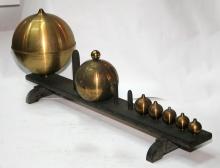Set of 6 brass resonators arranged by size on a wooden base. They used to be 10, but 4 are missing. The second biggest sphere is not a resonator, but the second hemispherical edge of the electrode of the Carré electrostatic machine of the School!
Each sphere has a hollow cavity and produces a sound of specific frequency. In general, the bigger the sphere, the more bass the sound it produces. Each sphere can be tuned to the same frequency as the one it produces itself. Consequently, if a composite sound impinges on the spheres, it will put in resonance only those spheres with the same natural frequencies as those of the overtones that create the original complex sound.
The Helmholtz resonators were used in various devices such as the Helmholtz’s device for the synthesis of sound and the Koenig’s device for the analysis of sound. Today similar devices are used to enhance sound speakers’ bass frequencies.

